Sikh Gurdwaras in Pakistan
Gurdwara Panja Sahib is one of the most awe-inspiring holy places for
Sikhism. Located in Hassan Abdal, Punjab,
it is believed that Guru Nanak’s own handprint is imprinted on a boulder
there.
Sikhs believe that water has been gushing from the same boulder from the
time of the handprint until today. I have
been lucky enough to visit this holy place twice and it is quite
spectacular. The gurdwara is surrounded by water
flowing from the boulder and huge fish in considerable amounts can be
found swimming here.
Many Sikhs live in the area with Muslims in an idyllic manner. The Muslims
here celebrate Sikh holy days with
them, while the Sikhs participate in Eid festivities with the Muslims.
There is decent lodging for Sikh pilgrims in the same gurdwara compound as
well as a Sikh school and
langar (community kitchen). Sikh pilgrims touch the handprint of the Guru
in respect and bathe in the water,
which is considered holy. This is one of the most frequently visited
religious sites for Sikh pilgrims.
Gurdwara Nankana Sahib
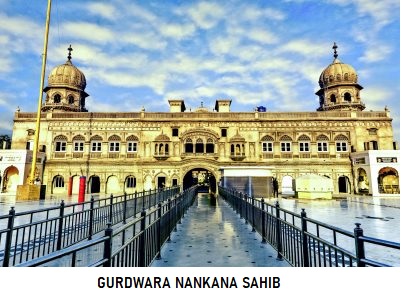
Near Lahore lies the historic city of Nankana Sahib, which hosts several
Sikh pilgrimage sites. Sikhs are
primarily drawn to the gurdwara known as Gurdwara Nankana Sahib due to it
being Guru Nanak’s birthplace –
this evidences its integral status to the Sikh faith. Gurdwara Nankana
Sahib is part of a collective of
nine other important gurdwaras in the city which are all endeared by
followers of Sikhism.
Gurdwara Dera Sahib and the Samadhi of Ranjit Singh
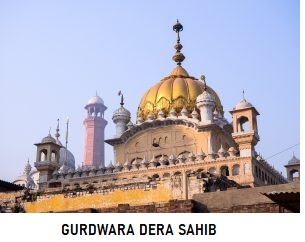
In Lahore itself, there are a few pilgrimage locations for followers of
Guru Nanak. Gurdwara Dera Sahib marks
the location of the death of the fifth guru of Sikhism, Guru Arjan. The
gurdwara is next to the iconic Mughal
constructed Badshahi Masjid. Sikh pilgrims arrive and perform religious
rites in the gurdwara on special occasions
such as the death anniversary of Guru Arjan. Adjacent to the gurdwara is
another religiously noteworthy place –
the Samadhi of Ranjit Singh. Ranjit Singh united the Sikh people and
established the prosperous Sikh Empire.
The Samadhi of Ranjit Singh is a beautiful building that houses his ashes
inside a marble urn.
Gurdwara Sri Sacha Sauda Sahib
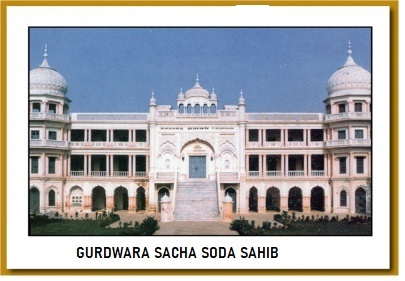
Gurdwara Sri Sacha Sauda Sahib is a gurdwara in Farooqabad, Punjab. The
gurdwara has ties to an event
involving Guru Nanak and his compassion for humanity. It is where the
gurdwara rests today that the Guru used
all his money, originally earmarked for business, to feed hungry people
that he encountered on his way.
Gurdwara Chowa Sahib
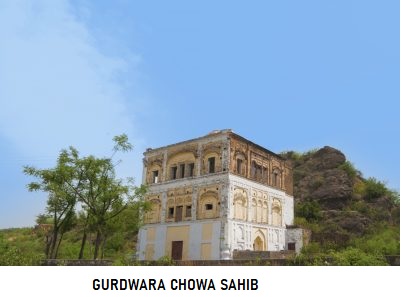
Quite recently, the Pakistani
government opened the doors of the extraordinary Gurdwara Chowa Sahib
in Punjab
after 72 years. The gurdwara is located near the legendary Rohtas Fort,
which is a UNESCO world heritage site.
The significance of this place is tied to Guru Nanak and Bhai Mardana –
the Guru’s long-time companion.
It
is believed that both were traveling during the summer when Bhai Mardana
expressed his thirst to Guru Nanak.
Upon hearing his friend’s plea for water, Guru Nanak struck his cane on
the earth moving a stone that revealed
a natural spring. The gurdwara marks the spot of this miracle – it was
constructed in 1834 and was commissioned
by Ranjit Singh. The gurdwara was opened in the run-up to Guru Nanak’s 550th birth
anniversary in November
2019. The ceremony, which reopened the gurdwara, commenced with an ardaas
(prayer) and kirtans
(devotional songs) by Pakistan’s Sikh community.
Gurdwara Darbar Sahib, Kartarpur
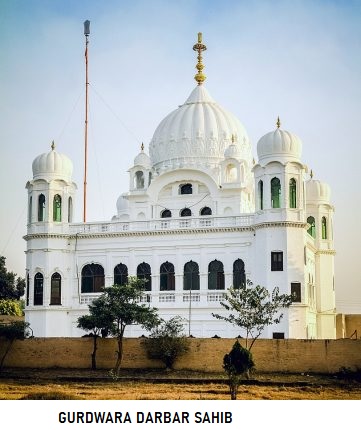
Lastly, and most importantly due to unfolding recent events, is the
Gurdwara Darbar Sahib Kartarpur. It is located
in Kartarpur, Punjab, and is situated inside Pakistan only a few
kilometers from the border with India. So close
is this gurdwara that it is visible from the Indian side of the border.
Sikh pilgrims on the Indian side use binoculars
to appease their religious sensibilities from afar. The magnetism that
pulls Sikhs to this place is again tied to
Guru Nanak. After his missionary work, he settled down in Kartarpur with a
loyal Sikh community. He remained
here until he eventually passed away. The gurdwara sits on the location
where he passed on. The Kartarpur
Corridor was a long-planned border corridor that would connect Dera Baba
Nanak, a gurdwara in India, with
Gurdwara Darbar Sahib,
in Pakistan, so that Sikhs could perform pilgrimage visa-free. In November
2018, in a move that all Sikhs extolled,
Prime Minister Imran Khan laid the foundation stone for the Kartarpur
Corridor.
Prime Minister Imran Khan was joined by two central Indian ministers and he
assured the Sikh community that
the corridor would be open before Guru Nanak’s 550th birth
anniversary in November 2019. The corridor was
in the mainstream news very recently both in Pakistan and India due to its
successful inauguration by Prime
Minister Imran Khan on November 9, 2019, where he welcomed 12,000 Sikh
pilgrims from Pakistan, India,
and other countries.
Three days later, on the 550th birthday
of the Guru, thousands of Sikhs poured into Kartarpur to perform the
pilgrimage. Sikhs from around the world and especially in India have
hailed the project. Perhaps via the corridor,
Guru Nanak and his tranquil legacy could help mollify the animosity
between Pakistan and India.
Ways to Improve Sikh Tourism in Pakistan
The influx of thousands of Sikhs entering Pakistan every year has
warranted the effective maintenance of
the aforementioned holy places of Sikhism as well as others. Most of the
sites mentioned above have good
lodging nearby; however, more can be done in terms of facilitating both
Sikh and non-Sikh tourists. Previously
forgotten
sites such as the recently reopened Gurdwara Chowa Sahib need to be given
further attention vis-à-vis maintenance. Signboards on the history of the
attractions should be provided in major languages.
Tour guides should be well-versed in Punjabi (the language of the Sikhs
and many people in Pakistan) and English.
In addition, leaflets in various languages should be provided.
Furthermore, a Sikh museum, similar to the Taxila
Museum (that houses legendary Buddhist relics), but with international
standards, should be created. This museum would benefit from being
situated nearby a Sikh shrine, such as the Panja Sahib or Nankana Sahib
Gurdwara.
Although many Sikhs are mindful of the most integral pilgrimage sites in
Pakistan such as Gurdwara Panja Sahib
and Gurdwara Nankana Sahib, the lesser-known holy
places of Sikhism must also be promoted heavily so that tourism and Sikh
heritage thrive. Concerning the international audience, which is largely
unaware of Sikhism’s connection to Pakistan, more must be done. For
example, Pakistan can try to place its historic Sikh sites on the UNESCO
World Heritage list so these locations garner international appeal.
Tourism video packages created by the government should mention Sikh and
Buddhist religious sites in the country. Furthermore, well-known Sikhs and
other vloggers should be invited to Pakistan to showcase not only the
majestic gurdwaras but also the hospitality of the Pakistani people. Pakistan
has been hosting thousands of Sikh pilgrims for decades but maintains a
ceiling on the total number of Sikh pilgrims allowed (due to frosty
relations with India). The Pakistani government provides medical
facilities as well as security to Sikh pilgrims and has continued to do so
every year. For Guru Nanak’s birth anniversary in 2016, 3,000 Sikhs
arrived to perform religious rites. In 2017, 2,600 Sikhs arrived to
celebrate the Guru’s birth anniversary while in 2018, 3800 Sikhs were
hosted by the country for the same watershed moment as it allowed
thousands of hopefuls to visit their holy places in Pakistan and will
yield even better results in the future due to
the Kartarpur Corridor. This can help improve the current abhorrent
relations between both nations. |